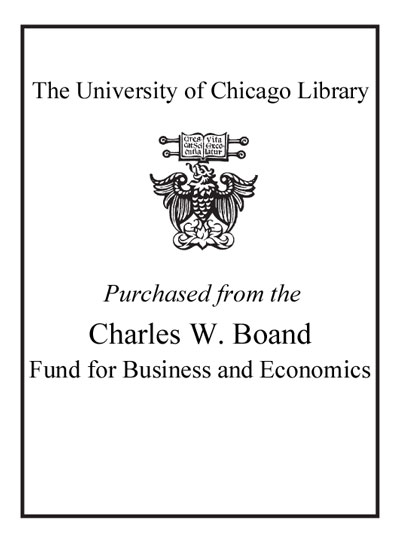Review by Choice Review
This excellent volume provides an invaluable lens through which to view modern banking and the ways it has evolved to privatize returns and socialize risks. The latest financial crisis provides another opportunity to recalibrate the governing rules in the direction of the public interest. However, in the US, the finding of the Financial Crisis Inquiry Commission (2010-11) included a clear rejection of forced structural change in systemically important financial firms. The UK's Vickers Commission report (2011) and EU's Liikanen Report (2012) likewise shied away from full-blown structural banking reforms. Admati (Stanford Graduate School of Business) and Hellwig (Max Planck Institute for Research on Collective Goods) provide an accessible explanation of the inherent risks in the current banking system and propose sensible rules and reforms to make the system stable without damaging bank lending or economic growth. It is difficult to argue with the authors' logic from the perspective of the public interest, but it is easy to see how the political economy of bank regulation could have left society highly exposed to the financial risk dynamics of the recent past. This timely volume is accessible to a wide readership. Summing Up: Highly recommended. All collections. I. Walter New York University
Copyright American Library Association, used with permission.
Review by Publisher's Weekly Review
Once upon a time the banking system was thriving, not a worry in sight. However, the 2007 financial crisis exposed the banks' inner workings and the risk taking that came at significant cost to the economy. Professor and journalist Admati and economic researcher Hellwig argue that it is possible to have a well-balanced banking system without any cost to society; weak regulations and lax enforcement is what caused the buildup of risk unleashed in the crisis. Here, they aim to demystify banking and expand the range of voices in the debate; encouraging people to form opinions and express doubts will ensure a healthier financial system as people understand the issues and influence policy. Part one provides an overview of how borrowing works and how it affects risk. Part two addresses the delicacy of the financial system and how its fragility can be reduced. Part three explains the possibility of transitioning to a healthier system that provides a solid system that consistently supports the economy. The authors push for aggressive reform by outlining specific steps that can be taken to change our banking system for the better; the question, is will anyone take those steps? (Mar.) © Copyright PWxyz, LLC. All rights reserved.
Review by Library Journal Review
Recent worldwide banking crises have forced governments to bail out and subsidize large banks because of what Admati (economics, Stanford Graduate Sch. of Business) characterizes as an ill-informed public perception that the institutions were too big to fail. Other misconceptions about the banking industry are addressed here as well, especially the false assumption that there is a tradeoff between banks' capital requirements and growth and profit. This book takes readers inside the global banking industry, examines the intricacies of banking operations, and addresses the major problems, including the banking system's overall "fragility." Macro solutions are offered that, the author maintains, will make the infrastructure more stable. Especially interesting is the discussion of how the current system rewards rather than penalizes risky decision making by individual bankers. VERDICT This title is a must read for management and human resource professionals within the banking industry as well as government policymakers. With its clear explanations, many examples, and analogies, the book is accessible to readers who do not have business backgrounds and who want to better understand banking.-Caroline Geck, Camden Street Sch. Lib., Newark, NJ (c) Copyright 2013. Library Journals LLC, a wholly owned subsidiary of Media Source, Inc. No redistribution permitted.
(c) Copyright Library Journals LLC, a wholly owned subsidiary of Media Source, Inc. No redistribution permitted.
Review by Kirkus Book Review
How to rebuild the banking system on a safe foundation and ensure it stays there. Admati (Finance and Economics/Stanford Graduate School of Business) and Hellwig (Director/Max Planck Institute for Collective Goods), authorities in the fields of financial and capital regulation, aim "to demystify banking and explain the issues to widen the participants in the debate." They accomplish the first objective by demolishing the arguments made by the representatives of the banking business against various regulatory reforms that have been proposed since the financial crisis of 2008. They show how banks seek to maintain their status as short-term, leveraged borrowers by obfuscating the meaning of words like "capital" and "capital requirements" and insisting, as the former head of Deutsche Bank Josef Ackermann did, that "higher equity requirementsreduces growth and has negative effects for all." Relying on equity as opposed to leverage, write the authors, was a well-established banking practice in the past and does not affect economic growth. They show that banks can build equity by re-investing profit rather than distributing gains to shareholders. As for the promised explanation of "the issues," they elucidate the subsidy that tax payers provide to banks directly, through deposit insurance, and indirectly, through the assumption of forthcoming bailouts. They also clarify the distinction between liquidity crises and solvency crises and assess the risk levels still tolerated and remaining within the financial system. They insist that "concerns about hidden insolvencies have still not been addressed." An important book for readers interested in what has been done, and what remains to be done, when it comes to safeguarding financial institutions.]] Copyright Kirkus Reviews, used with permission.
Copyright (c) Kirkus Reviews, used with permission.
Review by Choice Review
Review by Publisher's Weekly Review
Review by Library Journal Review
Review by Kirkus Book Review

